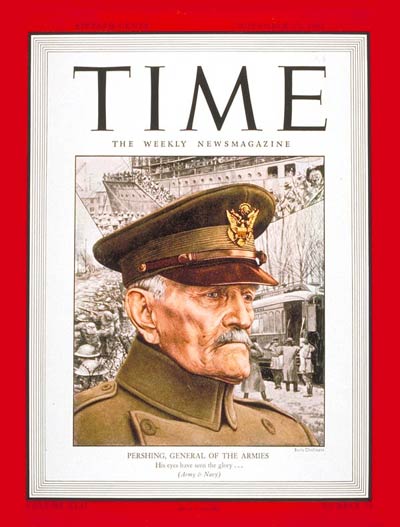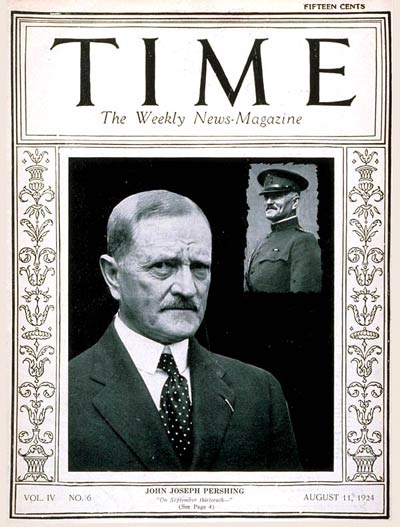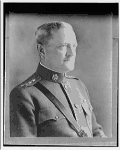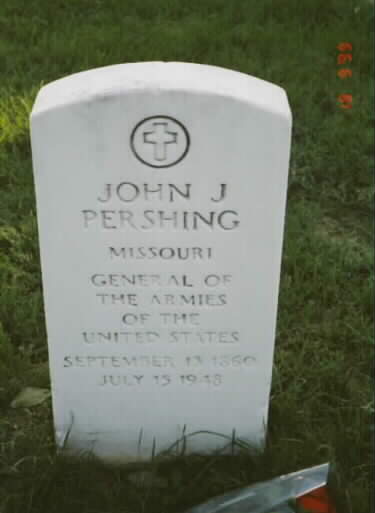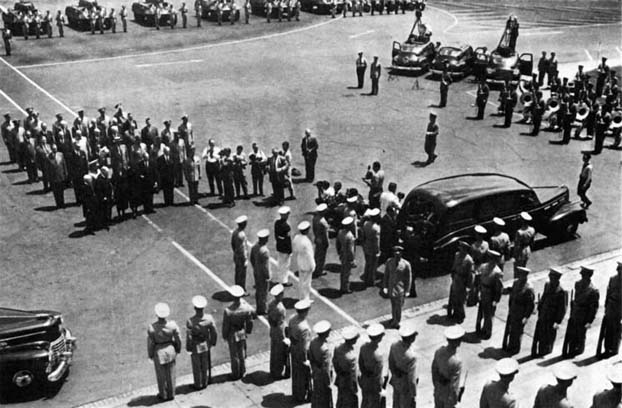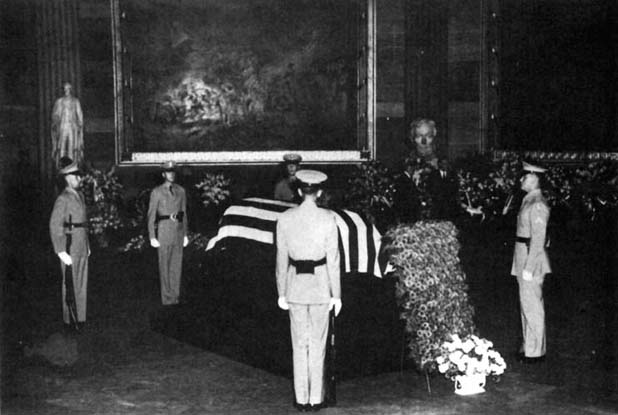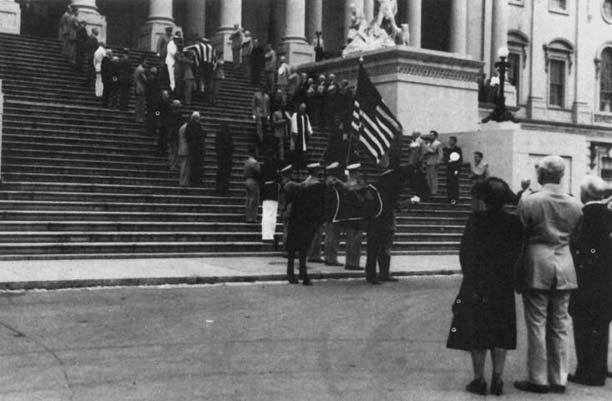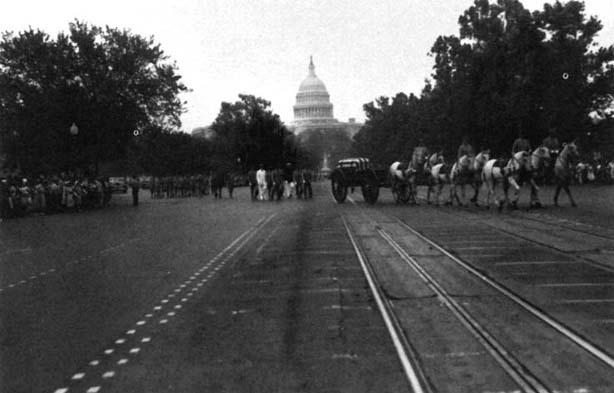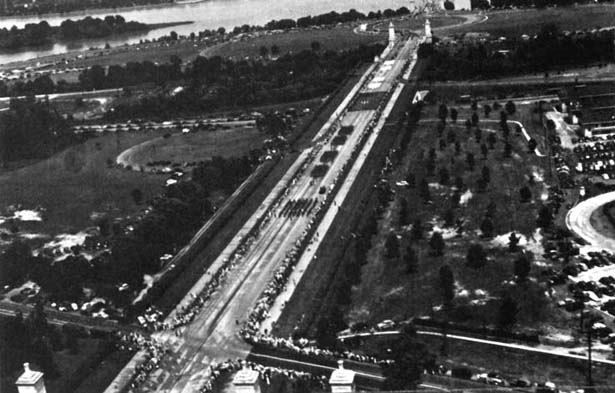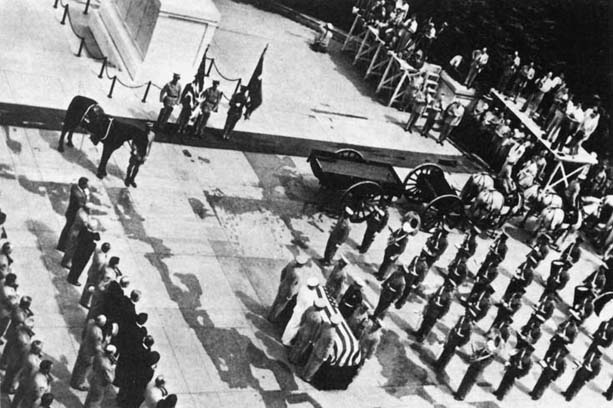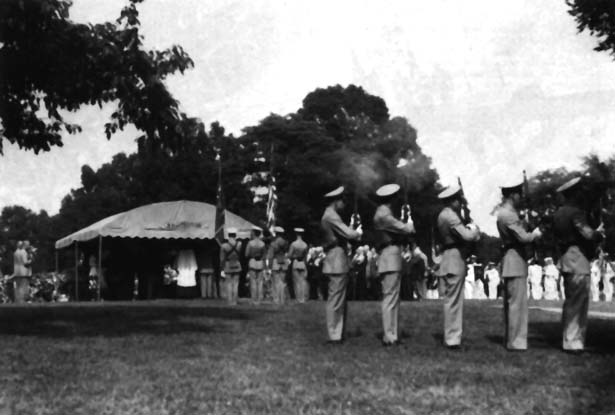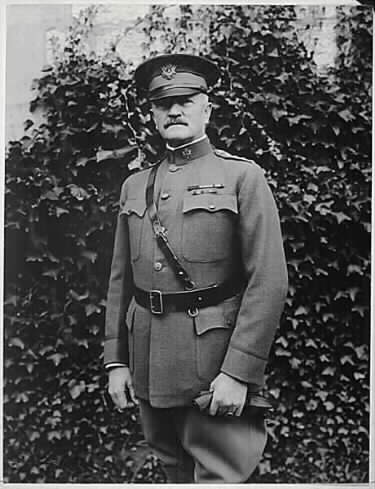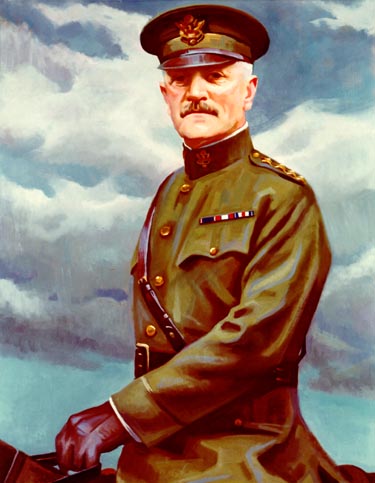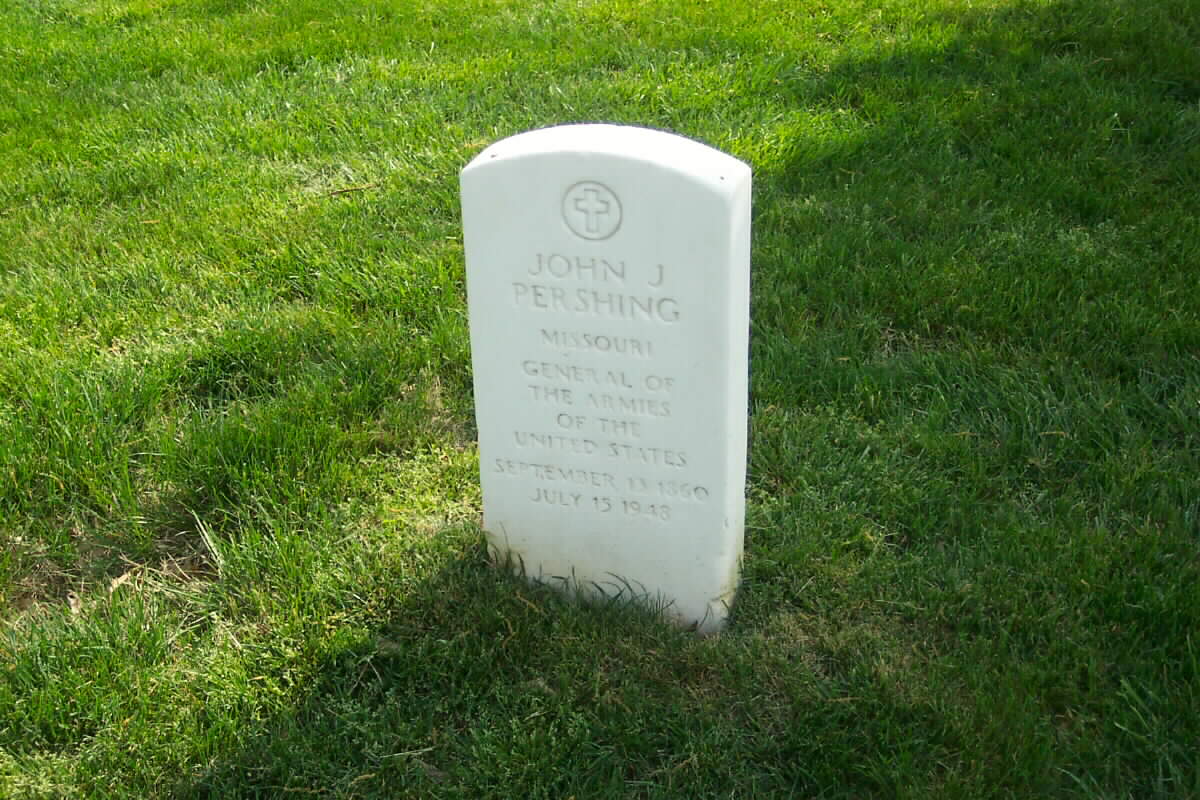One of America’s most famous Army officers, Pershing was born in Missouri on September 13, 1860. He graduated from West Point in 1886 and served in the Spanish-American War, the Philippines Insurrection, the Mexican Expedition and was the overall American Commander in Europe during World War I.
Following the war, he served as Army Chief of Staff.
He died at Walter Reed Army Medical Center in Washington on July 15, 1948. His funeral service, one of only a handfull ever held at the Memorial Amphitheater in Arlington National Cemetery, was attended by literally thousands of American citizens as well as by the leaders of government and the military. He was buried, as was his wish, under a simple white gravestone in Section 34 of Arlington National Cemetery, near the gravesites of his “Doughboys” from World War I.
His grandsons, Army Second Lieutenant Richard Warren Pershing, who was killed-in-action in Vietnam in 1968, and Colonel John Warren Pershing III, are buried beside him.
PERSHING, JOHN J.
- Brigadier General, U.S. Army
- Commander
- ecorations U.S. Army, Supplement V, 1941
- Home Town: Laclede, Missouri
- Date of Action: June 15, 1913
Citation:
The Distinguished Service Cross is presented to John J. Pershing, Brigadier General, U.S. Army, for extraordinary heroism in action against hostile fanatical Moros at Mount Bagsak, Jolo, Philippine Islands, on June 15, 1913.
Brigadier General Pershing personally assumed command of the assaulting line at the most critical period when only about 15 yards from the last Moro position. His encouragement and splendid example of personal heroism resulted in a general advance and the prompt capture of the hostile stronghold.
5 August 2006:
Lookin’ Back: Expectation of general’s demise was premature
PAUL L. ALLEN
Courtesy of the Tucson Citizen
In the World War I era, no American military figure was better known than Gen. John J. “Black Jack” Pershing.
So it was no surprise that reporters gathered like vultures circling a fresh roadkill when word got out in 1938 that Pershing was dying at a sanitorium in Tucson.
Pershing had accomplished the near impossible, whipping an ill-prepared American military into an effective, disciplined, 2 million-member fighting machine in World War I and then leading it to victory as its field commander.
The late Reba D. Grubb, who compiled a massive, two-volume history – “Portrait of Progress, A Story of Tucson Medical Center” – collected details of Pershing’s presence in the Old Pueblo.
He had been appointed chief of staff in 1921 and retired three years later as “General of the Armies.” Thereafter, he resisted the temptation to get into politics and declined to make public strategy suggestions about the uneasy world of the 1930s and 1940s.
Grubb wrote that the general and his sister, May, were “wintering” in Tucson in 1938, staying at the popular El Conquistador Hotel in February when he became ill. He was taken to the Desert Sanitorium of the Southwest, as TMC was known in its original incarnation.
The retired general was given medication and ordered to rest, but he was hospitalized at the sanitorium on February 22, attended by Col. Shelly U. Marietta of the Army Medical Corps, a nationally recognized heart specialist flown in from San Antonio at the family’s request.
Pershing was reported to have suffered “acute damage” to his heart muscles, with blood pressure dropping and a fever rising. He became comatose, and EKG testing showed “progressive myocardial degeneration.”
In other words, Pershing, then 78, was dying.
His son and other relatives were summoned, and as word spread, a horde of radio commentators, newspaper reporters, Army officers and others gathered, wanting to be the first to tell the world that the old warrior had died.
The sanitorium’s telephone system was overtaxed as calls came in, and more than two dozen newshounds hovered around the switchboard, hoping to assure themselves of an open line. They mooched cigarettes from each other and from visitors to the hospital and relied on the charity of hospital employees who not only tolerated their presence, but also sustained them with toast and jam, coffee and milk.
The intruders slept where and when they could, sitting in wheelchairs or sprawled on mattresses in the hallways and waiting room.
The rugged old general, known as a strict disciplinarian, regained consciousness, then once again lapsed into a coma. A doctor’s statement indicated Pershing’s condition “appeared unfavorable.” His kidneys ceased to function, and uremic poisoning set in. Anxious reporters were told “the end is approaching.”
Funeral arrangements were put in place, and a special rail car was waiting to transport his body to the East Coast. A World War I uniform Pershing wanted to be buried in was flown to Tucson. School would be dismissed, an honor guard was arranged, and florists stocked extra flowers.
But the old soldier outflanked the vultures.
He improved.
On March 2, he sat up and had a breakfast of Farina, though his intravenous tubes remained in place. By March 15, he was allowed out of bed for a brief walk. He soon left for New York City, accompanied by a doctor.
The following fall, fully recuperated, Pershing returned to Desert Sanitorium, bringing a retinue of servants and family members. He did so again in 1940, spending the winter season here.
On July 15, 1948, General of the Armies John J. Pershing died at Walter Reed Hospital in Washington, D.C. He was buried at Arlington National Cemetery.
The overeager reporters who descended on 1938 Tucson had misjudged his determination – and his demise – by a decade.
Complete Biography of General Pershing
Over a century has passed since Pershing’s birth and more than fifty years since his death, yet his memory stands tall in the land and his name rings firm in the historical echo of his times. General Pershing is the First World War, and the proof of this lies in the fact that after over fifty years no other general’s name comes readily to mind when that war is mentioned.
Pershing was born into the opening fanfare of the golden age of Grant, Lee, Sherman, and Jackson — four names that will stand linked forever before the fact of the preserved Union. Pershing’s earliest toddler memories were of Southern bushwhackers raiding his hometown and shooting up the village. He was five years old when Lee surrendered at Appomattox Courthouse.
He grew to manhood and as a junior officer served under Generals Nelson A. Miles, Adna R. Chaffee, John M. Schofield, and William R. Shafter- – four men indelibly associated with the march of America across the shrinking plains, to Cuba and the Orient, while the 19th century wound its way out and the century of great wars came upon us.
In the First World War, however, Pershing played his part without peer-standing alone in his time as history would have it, and with no one to share the fame.
Pershing grew very old and lived on to see the new men come to flower — MacArthur and Eisenhower, Patton and Stilwell, all of whom he outranked by an active commission as General of the armies by Act of Congress as long as he lived — but never once did he attempt to put finger in the New War pie. Like a wise old soldier, he spent the Second World War quietly fading away.
In 1944, when Pershing was in Walter Reed Hospital, the Old Man was eighty-four years old, and he had been living up on top of the hospital in his specially-built set of quarters for the three years that the Second World War had been going on. The Old War was pretty far back in history by this time; yet it was a mark of the stature of Pershing that his nurses scheduled receiving hours each morning for seldom less than three or four people who felt impelled, by right of past association and present desire, to call and pay their respects when passing through Washington. It was a mark of the gallantry that never dies in old cavalrymen, one supposes, that the comelier nurses would grin at times and rub themselves where they swore they’d been pinched.
Of all men of his time, he seemed to have an unerring instinct for just where he fitted in the scheme of things. When age came upon him, he met it with the cool dignity that marked his intercourse with even his close friends. He made no effort to inflict his aging mind on the nation as a senior citizen. He wrote no carping, critical books. He did not sell his retired sword to commerce. He was, in essence, a dirt soldier who came up the hard way, but who loved his profession dearly enough to continue the pursuit of excellence in it– the hard way.
So when his time came, he folded his cloak about him and quietly departed, almost a stranger to the new war that had come upon his country, but forever a part of the careful binding to meet threats that will bring victory once more when the time comes.
Pershing’s father, John Fletcher Pershing, was a boss tracklayer for the North Missouri Railroad at Warrenton, Missouri, where he met Ann Elizabeth Thompson. On 22 March 1859, they were married. Soon after, they moved to a shanty on the farm of Judge Meredith Brown near Laclede. John Joseph was born there on 13 September 1860.
When the Civil War began, John Fletcher moved to Laclede and bought Lomax’s General Store. He bought two farms, one 80 acres, the other 160 acres, and a lumberyard. He also became the sutler for the 18th Missouri Volunteer Infantry, then quartered at Laclede.
In 1865, a “select school for small children” was opened in Laclede. John and his brother, James attended this school. Between 1870 and 1873, John Fletcher lost the greater part of his land holdings in speculation, and in 1876 became a traveling salesman. During this time, John Joseph worked on his father’s farm and attended school, and later taught the Negro school at Laclede. Throughout this sometimes difficult period, the future General Pershing demonstrated the qualities which would always be paramount in his life: self-possession, competence, level-headedness, dependability, and the ability to see things through.
In October 1879, Pershing became the teacher of the school at Prairie Mound, nine miles from Laclede. During the summers of 1880, 1881, and 1882, he went to the State Normal School at Kirksville, Missouri. In the spring of 1882, Pershing saw an announcement for a competitive examination for an appointment to West Point. He had no desire to become a soldier but he saw an opportunity for an excellent education. On the advice of his sister, he took the examination and won the appointment.
Pershing was not a brilliant scholar. He graduated 30th in a class of 77. But the officers and his classmates at West Point recognized that he had a rare quality of leadership. General Merritt, then Superintendent of West Point, said that Pershing showed early promise of becoming a superb officer. He was elected president of the class of 1886. Each year he held the highest possible rank in the Cadet Battalion. Thirteen years before the Spanish-American War began, Cadet Captain Pershing commanded the Corps of Cadets when it crossed the Hudson from West Point to Garrison to stand at present arms while the funeral train of Ulysses S. Grant rolled slowly by.
Pershing did not think much of army life in peacetime and during his furlough he expressed a desire to take up the study of law. During his last year at the Point, he and four classmates formed a scheme for an irrigation project in Oregon, but nothing ever came of it.
After his graduation from West Point, Pershing was assigned to Troop L, 6th Cavalry, Fort Bayard, New Mexico. He reported for duty on 30 September 1886. He scouted hostile Indians and commanded a detachment which set up a heliograph line 160 miles through the mountains. This latter accomplishment was no small feat. The detachment was out about a month and lived off the country, which was inhabited by hostile Indians.
A group photograph of the 6th United States Cavalry, taken on the club steps at Fort Bayard, New Mexico, show among them the very junior Second Lieutenant Pershing, blue kepi cocked on his light blond head and a kid’s grin on his face. For four years in the desert Southwest, he was on active service against the last of the Apaches. He served throughout the Santiago Campaign fighting at San Juan Hill, where he was cited for gallantry 1 July 1898, and for which he was subsequently awarded the Silver Star Medal. In the words of his commanding general, S. M. B. Young, he was “the coolest man under fire that I ever saw.”
In 1887, Pershing was transferred to Fort Stanton, where he took part in maneuvers. In 1889, he stood second in pistol marksmanship in the California and Arizona divisions of the Cavalry and 22nd in rifle marksmanship in the Army. In 1891, he stood second in pistol and fifth in rifle marksmanship. On 23 November 1890, the 6th Cavalry was ordered to South Dakota. It arrived at Rapid City on 9 December 1890. That winter, a most severe one, was spent in putting down one of the final Sioux uprisings.
On 15 September 1891, Pershing took up his duties as Professor of Military Science and Tactics at the University of Nebraska. During the four years he held this post, he showed qualities of character that were prophetic of the way that he would acquit himself should the Army call him to a bigger role on a bigger stage. This statement is based entirely upon statements and letters contemporaneous with his service at Nebraska when he was still an unknown second lieutenant.
Upon his arrival at Nebraska, Pershing found few men, the interest in the battalion weak, the discipline next to nothing, and the instincts of the faculty and the precedent of the University against the Cadet Corps. The sentiment of the community faculty, and student body (and, in fact, that of the whole nation) was pacifistic. No one thought that there would be another war. The accepted recipe for army-making which William Jennings Bryan made famous and which World War I proved utterly false, was that “A million men (would) spring to arms overnight.” He could have drawn his pay and courted popularity by drifting with the tide, but he was not made that way. Here as elsewhere, Pershing was a strict disciplinarian.
In 1892, the National Competitive Drills were held in Omaha. Pershing, after much opposition, entered a company. Using Company A as a nucleus, he built up a drill company. It drilled from seven until nine in the morning and from four until seven in the afternoon. In the maiden competition, Company A won the Omaha Cup and $1,500. That same year, Chancellor Canfield requested that Pershing be permitted to remain at the University another year. This request was granted by the War Department. While at Nebraska, Pershing studied law and graduated with the class of 1893.
On 1 October 1895, Pershing was ordered to join his regiment at Fort Assiniboine, Montana. He had been appointed a First Lieutenant in the 10th Cavalry. While on duty in Montana, Pershing was active in rounding up a large group of renegade Creeks and deporting them to Canada.
In June 1897, Pershing was assigned to West Point as an assistant instructor in Tactics. He was not a popular officer there because the cadets thought his discipline was too strict.
On 2 May 1898, after Colonel Henry of the 19th Cavalry had requested it and Major General Miles recommended it, Pershing was relieved from his duties at West Point and joined his Regiment at Tampa as Regimental Quartermaster. Pershing was mentioned in the report of LTC T. A. Baldwin, commander of the 10th Cavalry, to the War Department for his untiring energy, faithfulness, and gallantry. In this report he was also recommended for a brevet commission. On 26 August, Pershing was commissioned Chief Ordnance Officer of volunteers with the rank of Major and was ordered to Washington for that duty. Unfortunately, he was suffering from malaria and was confined at home.
On 10 March 1899, Pershing was placed in charge of the Division of Customs and Insular Affairs, a new division within the War Department. It was created to meet the emergency caused by the necessity of providing the military government for our new insular possessions: Cuba, Puerto Rico, the Philippines, and Guam.
On 17 August 1899, he was ordered to Manila, the Philippines, to report to the Commander of the Eighth Army Corps for duty. On 1 December, he was assigned to the Department of Mindanao and Jolo. In cleaning up the Moro insurrectionists, Pershing, as Adjutant General of his Department, was in active service from 27 November 1900 until 1 March 1901. He participated in the advance up the Cagayan River to destroy the stronghold of Macajambo. The expert handling of these expeditions was noted even in Washington: Secretary of War Elihu Root, the father of the Command and General Staff School at Fort Leavenworth, in 1903 said on record to D. Avery Andrews: “If your friend Pershing doesn’t look out, he will find himself in the Brigadier General class very soon.”
On 2 February 1901, Pershing was made a Captain and was transferred to the 1st Cavalry. In August of that year, it was ordered back to the U.S. Pershing applied for transfer to the 15th Cavalry, then taking up its station in the Philippines. The request was granted, and he served in various departmental roles until 11 October, when he took charge of the post at Iligan.
There, Pershing won the confidence of and made friends with a few Datos from the north of Lake Lanao. He learned the Moro language well enough to converse with the Moros.
After LTC Baldwin had advanced to Lake Lanao, captured Fort Padapatan, and founded Camp Vicars (named in honor of LT Thomas A. Vicars, who was killed during the attack on the Fort), Pershing was sent to the camp. He acted as Intelligence Officer and on 30 June 1901, he succeeded LTC Baldwin as Commander of Camp Vicars, the Colonel having been made Brigadier General.
On 28 September 1901, after numerous attacks had been made on the outposts of Camp Vicars, Pershing began the first of a series of four campaigns against the Moros. On the fourth one, he completely circled Lake Lanao, a feat never before accomplished by a white man.
After three and a half years of active service, Pershing was ordered home in June 1903. Before his departure, a movement was carried out among the officers of the Army to have Pershing made a Brigadier General as due recognition of his services and his demonstrated military ability. This movement was carried out by men best fit to judge Pershing’s worth as a General Officer: Major Generals Davis, Summer, Murray, and Wood; Brigadier Generals Sanger, Burt, and Pandal.
While in Washington, after his return from the Philippines, Pershing met Miss Helen Frances Warren, whom he later married. Miss Warren’s father was a Senator from Wyoming.
When Congress met on 7 December 1903, President Roosevelt, in his message to Congress, mentioned Pershing by name. It was in connection with that portion of his message dealing with the promotion system of the Army. He said that when men render such a service as Captain Pershing did in the Philippines, it should be possible to reward him without at once jumping him to the rank of Brigadier General. This is one of the few occasions when an Army officer has been mentioned by name in the President’s message to Congress.
In 1904, Pershing was assigned to duty in Oklahoma City as Assistant Chief of Staff, Southwest Division. That fall, while on leave, he visited the Warrens at their ranch in Wyoming. On 31 October 1904, he was assigned as a student at at the Army War College and was ordered back to Washington.
When Congress met in December, the Warrens were again in Washington, and Pershing was assigned as a military attache in Tokyo. This assignment brought his long courtship with Miss Warren to a close. They were married on 26 January 1905, and sailed for Tokyo the following day. Pershing spent most of his nine-month tour of duty in Manchuria observing the Russo-Japanese War.
Shortly after Pershing’s first child, Helen Elizabeth, was born, President Roosevelt promoted Captain Pershing to Brigadier General. However, Pershing’s long years of service, his splendid record, and his achievements in the Philippines were all forgotten by critics. They also forgot that three years had passed since the President had urged Congress to remove the necessity of such promotions to reward merit. Also overlooked were the precedents for this promotion. Major Tasker H. Bliss, Captains Leonard Wood, Frederick D. Grant, Frederick Funston and Albert L. Mills had all been promoted to Brigadier General, the latter just before Pershing himself. All of these promotions were made in the considered interest of Army efficiency at a time when the service was bound by passively entrenched rank, living on the inertia of seniority. The many critics remembered only that Pershing was the son-in-law of Senator Francis E. Warren, Chairman of the Senate Committee on Military Affairs. “His promotion,” they declared, “was a flagrant example of pull.” In answer to such criticism, Roosevelt said, “To promote a man because he married a Senator’s daughter would be an infamy; to refuse him promotion for the same reason would be an equal infamy.”
Shortly after his promotion, General Pershing was asked whether he would prefer an assignment in the Philippines or to command the Department of the Gulf. He replied that he preferred active service and would leave the assignment to the War Department. Unfortunately, the War Department had some trouble seeing a clear decision through all the red tape. Pershing was ordered to report to San Francisco for further orders. He left Tokyo and went to San Francisco. He had just arrived there when he was directed to go to the Philippines. He had to get special permission to go by way of Tokyo to get his family and property.
Upon reaching the Philippines, Pershing was placed in command of Fort McKinley, near Manila. On 24 March 1908, Pershing’s second child, Anne, was born at Baguio, the summer capital of the Philippines.
In the fall of 1908, war seemed imminent in the Balkans. Pershing was directed to proceed to Paris and, if war broke out, to go as a military observer. He and his family were in Paris for two months. When the hostilities in the Balkans died down in 1909, they returned to the United States.
Meanwhile the Moro situation in Mindanao and the Sulu Islands had again become troublesome. Governor Smith of the Philippines recommended that General Pershing return, but due to complications arising from malaria that Pershing had contracted in Cuba and the Philippines, he was prevented from returning there. He requested that no one be permanently assigned to the post.
On 24 June 1909, Pershing’s only son, Francis Warren, was born in Cheyenne, Wyoming, Pershing’s only child born in the United States.
In October of that year, Pershing, now recovered from his illness, sailed for the Philippines to take charge of the Moro Province as Military Governor. Under his leadership, the hostile Moros were disarmed, by peaceful methods when possible and by force when necessary. Peace was gradually restored.
On 20 May 1912, Pershing’s fourth and last child, Mary Margaret, was born. Soon afterwards, the entire Pershing family was baptized into the Episcopal faith by Bishop Brent, a close friend of Pershing.
In 1913, General Huerta had seized the reins of the Mexican government. The United States refused to recognize the new government and diplomatic relations were severed. General Pershing, about to sail for home after four years of service in the Philippines, applied to the War Department for assignment to active service in the event of hostilities with Mexico. When Pershing arrived in Honolulu on 20 December 1913, he received orders to report to the 8th Brigade at San Francisco, the first Brigade on the roster in case of “hostilities.”
On 20 January 1914, Pershing, with the 8th Brigade, began patrolling the Mexican Border, leaving his wife and his four young children in quarters at the Presidio of San Francisco. After a year’s stay at Fort Bliss, Pershing decided to bring his family there. The arrangements were almost complete when a tremendous tragedy occurred at the Presidio on 27 August 1915: the quarters were destroyed by fire and Mrs. Pershing and the three little girls died in the holocaust. Only his son Warren survived. What this does to a man, no other can say. At best, a part of him must seal up forever, wherein the dead never grow up or grow older; only the broken heart that holds them in anguish does.
This tragedy was a part of the great and natural dignity of Pershing, of which Heywood Brown once wrote: “They will never call him Papa Pershing.” It was dignity that impelled only the long- service soldiers to call him “Black Jack” as a subtle accolade, not in derogation.
After the funerals at Cheyenne, Pershing returned to Fort Bliss with his son Warren and his sister Mae and took up his duties as commanding officer again. He sought and found solace in hard work. He finally regained mastery of himself, though it was feared for a while that he might lose his mind.
On 15 March 1915, Pershing led an expedition into Mexico to capture Pancho Villa. This expedition was ill-equipped and hampered by a lack of supplies due to the breakdown of the Quartermaster Corps. Although there had been talk of war on the border for years, no steps had been taken to provide for the handling of supplies for an expedition. Despite this and other hindrances, such as the lack of aid from the former Mexican government, and their refusal to allow American troops to transport troops and supplies over their railroads, Pershing organized and commanded the Mexican Punitive Expedition, a combined armed force of 10,000 men that penetrated 350 miles into Mexico and routed Pancho Villa’s revolutionaries, severely wounding the bandit himself. There is a prophetic photograph surviving from those days: a picture taken at Nogales of Generals Obregon, Villa and Pershing. Behind Pershing and to his left stands First Lieutenant George S. Patton, Jr.
On 3 April 1917, the United States declared war on Germany. On 7 May, Pershing was ordered to Washington, and later that month he sailed to Europe with the nucleus of a General Staff.
The story of Pershing’s appointment to the command of the American Expeditionary Force is not generally known, for it is loosely assumed that he fell into it naturally after the death of General Frederick Funston. But this is not so. Newton D. Baker, Wilson’s Secretary of War, had had no previous acquaintance with Army matters before his Cabinet appointment. The Chief of Staff in 1917 was Major General Hugh L. Scott, a distinguished and capable officer, but in his 64th year, faced statutory retirement in a matter of months. When it became imperative to select a field commander, Secretary Baker took home the complete records of all general officers and spent almost 48 continuous hours examining them minutely against each other. It is a testament to Pershing’s greatness that when Secretary Baker announced his choice, he was completely certain in his selection of General Pershing; there was no second on the record.
There was no American Expeditionary Force per se for Pershing to command at the time of his selection. The Regular Army had perhaps 25,000 men in 1917, and there was no divisional organization except for the hastily scratched-up 1st Division, elements of which were still landing in St. Nazaire in early July, three months after the declaration of war. There was no reserve as we know it today except the Officer’s Training Camps of Plattsburg Movement. To attend one of these camps, prior to the declaration of war, a man had to buy his own uniforms, pay for his own food and incidentals, and transport himself to and from his home. He received no pay, but he could get an Officer’s Reserve Corps commission and wear ORC in bronze on his collar. The National Guard outfits in most states were separate companies that quite possibly had never trained in regiment. A long enough time had elapsed since the Spanish-American War that politics had crept back into the selection of senior officers, taking precedence over qualifications.
Pershing was now entering upon the most difficult task of his career. He had the unenviable job of producing a completely organized army. It would take months, possibly a year, to get that Army into the field. Pershing soon found out that the English and French did not even want an American army; they wanted men.
Nobody but the Regular Army ever trained progressively for war in the United States before World War I, and the regulars never trained on the massive scale that European armies had since the days of Frederick the Great. The prevailing American belief was that if war came, one just blithely sprang to arms overnight. Again, in the words of William Jennings Bryan, “never mind what arms you sprang to, or who fed you breakfast the next morning.”
Pershing’s task was doubly difficult. Not only did he have to deny the men that the French and English needed, but he had to depend on those allies for supplies. The first divisions that arrived in France had been trained by the French, who expected this to be a permanent arrangement, and wanted the American troops to be brigaded with the French, under command of French Divisional Officers. This Pershing absolutely would not allow.
Pershing was not an “overnight springer.” Having previously commanded four brigade-sized expeditions in hostile territory, he respected the supply and administration “which come before all glory and without which there is no military diversion of fighting a war.” Furthermore, Pershing had spent many years training men. The two-sided maneuver, which later became Army doctrine, was modestly born in his unit at Fort Bayard, New Mexico, in 1886, when General Nelson Miles instituted “raiding games” wherein one cavalry troop took the part of the raiding Apaches and the others countered their efforts. Pershing carried on the method of the Philippines– building training into pyramidal structure from the individual through units to combined arms–and employed physically opposed maneuvers of two counterbodies of troops.
Pershing was one of the leaders in the movement for the establishment of a Supreme Commander, as opposed to a Supreme War Council. He also demanded that the American Army (then still in the process of building) should be included in the agreement.
Though they began randomly in the National Army of 1917- 1918 (some men were overseas two weeks after induction), the methods and training programs that Pershing inaugurated early in 1917 were the beginnings of the masterfully refined mobilization training plan of 1941-1945 that produced the finest, most far-flung army the world had ever seen. In spite of great pressure, official, diplomatic and otherwise, Pershing had been able to produce an integrated fighting force of two million men in 18 months, and to fight with it himself as field commander in the last few months of the war.
America’s prominent position in world affairs today is largely the result of Pershing’s activities in Europe. If he had less firmly insisted on an independent American Army, and American soldiers were divided among English and French forces, the power of the American government at the peace conference would have been negligible and the American nation would not likely be the world power it is today.
In the spring of 1918, the Germans began their last desperate drive on Allied positions. Realizing that a united front was necessary to stem this attack, Pershing placed the American troops under the command of General Foch of France, who had assumed the Supreme Command of Allied armies in Europe. Under the weight of the superior and brilliantly led fighting force, the German were crushed. Celebrations and decorations heralded the return of General Pershing and his Army to his country.
General Pershing cannot be too highly commended for his attitude and actions since the war. He did not make the mistake of trying to tell the nation how it should be run, and above all, he did what few victorious generals have ever done: he stayed out of politics.
In 1921, Pershing was appointed Chief of Staff of the United States Army. In 1924, at the age of sixty-four, he retired from active duty with the title of “General of the Armies” bestowed on him by Congress.
Ill health forced the famous soldier to retire from all public service soon after his retirement. Held in the highest esteem by contemporary members of his profession, his advice was sought on military matters despite his retirement. He advocated a program of military preparedness for his country and throughout the remaining years of his life he kept in close contact with military developments.
On 15 July 1948, John Joseph Pershing passed away at Walter Reed Hospital in Washington, D.C. Tributes of the greatest men of our time were given him on the days following his death. But men of the Army will always pay tribute to General John J. Pershing. A life such as his is a challenge to his followers in the military profession, and they have accepted that challenge. John Joseph Pershing, soldier and citizen, will live forever in the memory of the men of our victorious country.
General of the Armies John J. Pershing
State Funeral
15-19 July 1948 General of the Armies John J. Pershing, then the nation’s highest ranking military official, died on 15 July 1948, at the age of eighty-seven, at the Army’s Walter Reed General Hospital, Washington, D.C. He had been a patient there since 6 May 1941, residing in a small wing set aside for him.
A plan to honor General Pershing with a State Funeral had been written ten years earlier when he seemed near death. After his recovery, the plan was closely guarded and over the decade following was substantially revised to incorporate changes directed by the Army Chief of Staff with the consent of F. Warren Pershing, the general’s son. The version finally used was prepared in 1945 (and classified Top Secret), but it included some changes made later.
The plan met the preferences of General Pershing. Years before his death he had expressed a wish to be buried in Arlington National Cemetery and had selected a small hill in a southeastern section of the cemetery as his gravesite. The ground sloped away from this site to a level plot containing the graves of hundreds of men whom he had commanded in World War I. A military man for sixty-six years, General Pershing had insisted upon a purely military funeral. Accordingly, the plan restricted organizational participation in the ceremonies to the active Army, Navy, Marine Corps, and Air Force. The National Guard, the Organized Reserve Corps, and patriotic organizations were to be represented only in the audience invited to attend the funeral service.
The ceremonies were scheduled for 17-19 July. For twenty-four hours the general’s body was to lie in the chapel at Walter Reed General Hospital, to be visited only by relatives, close friends, members of the hospital staff, and long-time fellow patients. For another twenty-four hours the body was to lie in state in the rotunda of the Capitol, where the public would be admitted. During the afternoon of the third day, General Pershing’s body was to be escorted by a procession from the Capitol to Arlington National Cemetery for honors at the Tomb of the Unknown Soldier, funeral service in the Memorial Amphitheater, and last rites at the gravesite.
Following protocol established in the funeral plan, the commanding general of Walter Reed General Hospital, Major General George C. Beach, was to announce General Pershing’s death first to President Harry S. Truman who would make the public proclamation. When General Pershing died at 0350 on 15 July, President Truman was en route by train to Washington from Philadelphia. General Beach was at Washington’s Union Station when the President’s train arrived at 0515 and notified the President’s secretary.
At 0830 President Truman announced General Pershing’s death from the White House in a statement paying tribute to the general. The Department of State later in the day issued the President’s proclamation of a period of national mourning in which it was ordered that the national flag be displayed at half-staff “upon all public buildings and at all forts and military posts and naval stations, and on all vessels of the United States” until funeral services had been held.
According to the order of notification, General Beach meanwhile sent word of General Pershing’s death to the Army Chief of Staff, General Omar N. Bradley. Word, in turn, reached Headquarters, Military District of Washington, the executive agency designated to conduct the funeral, and the agencies of the Department of the Army staff responsible for specific details of the arrangements. (Table 3) The commander of the Military District of Washington, Major General Hobart R. Gay, acting as the direct representative of the President, coordinated arrangements for the ceremonies from an operations center established in the Pentagon early on 15 July. One of General Gay’s first acts was to request the use of the rotunda of the Capitol for the lying in state ceremony. Such a request ordinarily results in an act of Congress, but in this instance, since Congress was in adjournment, the Speaker of the House, Joseph W. Martin, Jr., and the president pro tempore of the Senate, Arthur H. Vandenberg, gave joint consent. In an early administrative step, General Gay downgraded the highly classified funeral plan after the President announced General Pershing’s death and authorized the extraction of information from it for release to the press.
TABLE 3-RESPONSIBLE ARMY AGENCIES, CEREMONIES FOR GENERAL OF
THE ARMIES JOHN J. PERSHING
Agency Responsibility
——————————————————————————–
Headquarters, Military District of Washington. Executive handling of all funeral arrangements and ceremonies.
Secretary of the General Staff -Assistance to the Pershing family, General Staff heads, Chief of Staff, Secretary of the Army, Secretary of Defense, members of Congress, and the President in their participation in the ceremonies.
Director of Personnel and Administration (delegated to The Adjutant General). Processing of all invitations, announcements, and orders pertaining to General Pershing’s death and the funeral ceremonies.
Director of Organization and Training. . Selection and movement of ceremonial troop units stationed outside the Washington area.
Chief of Chaplains – Arrangement of religious services.
TABLE 4-PARTICIPATING UNITS, CEREMONIES FOR GENERAL
OF THE ARMIES JOHN J. PERSHING
Unit – Station
1st Battalion, 504th Airborne Infantry Regiment, 82d Airborne Division. Fort Bragg, North Carolina
3d Infantry Regiment, Fort Myer, Virginia
3d Mechanized Cavalry Reconnaissance Squadron. Fort Meade, Maryland
410th Engineer Construction Battalion.. Fort Belvoir, Virginia
456th Field Artillery Battalion, 82d Airborne Division. Fort Bragg, North Carolina
1 Battalion, Cadets, U.S. Military Academy, West Point, New York
2 Squadrons, Air Force troops, Boiling Field, Washington, D.C
1 Company, bluejackets, Potomac River Naval Command, Washington, DC
1 Company, marines, Marine Barracks, Washington, DC
US Army Band, Fort Myer, Virginia
US Army Ground Forces Band, Fort Meade, Maryland
356th Army Band, Fort Belvoir, Virginia
1 Squadron, Air Force planes
All military units that were to participate in the funeral were alerted by noon on 15 July; through the afternoon, officers representing units that were to act as escort in the funeral procession joined Military District of Washington officials in conference on details and procedures. Of the units with distant home stations, two battalions from Fort Bragg, North Carolina, were scheduled to move in convoy on 17 and 18 July into temporary quarters at Fort Belvoir; Virginia; a battalion of cadets of the US Military Academy, coming directly from summer field maneuvers, was to proceed by train from West Point to Washington early on 19 July, the day of the funeral.
Alongside the Military District of Washington operations center in the Pentagon, The Adjutant General opened a center on 15 July to process invitations, announcements, and orders, all of which already existed in draft form. He issued general orders announcing General Pershing’s death to the Army and specifying that the flag be displayed at half-staff for thirty days “at the headquarters of all military commands and vessels” under the control of the Department of the Army. Later, because special arrangements to accommodate the Army’s longer period of mourning were lacking, the flags at several buildings in the Washington, DC, area occupied by the Army but administered by the Public Buildings Administration were raised to full staff immediately after General Pershing’s funeral, as prescribed for government buildings in the Presidential proclamation.
By evening of 15 July, The Adjutant General’s center had dispatched all necessary telegrams and letters of notification of death and had forwarded credentials to some 3,000 persons invited to attend the funeral. (Since the number of guests approximated the seating capacity of the Memorial Amphitheater, the public could not be admitted to the funeral service.) Among those who received invitations were the honorary pallbearers (officers and dignitaries) and honorary body bearers (enlisted men), among them Sergeant Alvin C. York of World War I fame. The center’s staff over the nest three days was fully occupied in handling the responses to these communications.
Virtually all other preliminary arrangements, administrative and ceremonial, were completed on 16 July. Among changes to the basic funeral plan that had to be considered, some of them made near the last moment, was President Truman’s decision not to deliver a eulogy previously scheduled for the funeral service. He also canceled the 21-gun salute that otherwise would have accompanied his arrival at and departure from Arlington National Cemetery. The honor in this instance, he considered, would constitute an interruption of the funeral rites.
Secretary of Defense James V. Forrestal changed his plans to participate in the ceremonies, electing to attend only the funeral service in the Memorial Amphitheater. He delegated his role in the ceremonies to Secretary of the Army Kenneth C. Royall.
A proposal that a six-star insignia be affixed to General Pershing’s uniform was dropped in favor of the four stars the general had always worn. Finally, at the request of the Pershing family, a plan to display the general’s medals during the lying in state period at the Capitol was canceled.
General Pershing’s body was placed in the Walter Reed General Hospital chapel at noon on 17 July. The Ceremonial Company, 3d Infantry Regiment, furnished an honor guard, as well as a chapel guard to guide persons paying their respects. Hospital staff members and patients were admitted to the chapel from 1300 to 1900. All other hours of the period, ending at 1300 on 18 July, were reserved for the Pershing family and close friends.
At the closing hour General Gay, as escort commander, took charge of General Pershing’s body at the chapel for movement in the procession to the Capitol for the formal lying in state. The 356th Army Band from Fort Belvoir, Virginia, played a hymn as body bearers (four Army, two Air Force, one Navy, one Marine Corps) moved the casket to a coach. The cortege of coach and family cars escorted by a scout car detachment from the 3d Armored Cavalry Reconnaissance Squadron, Fort Meade, Maryland, and Metropolitan Police proceeded at normal speed via 16th Street, Massachusetts Avenue, and New Jersey Avenue, reaching the East Plaza about 1330.
In formation to receive General Pershing’s casket at the Capitol were the three service secretaries, the Army Chief of Staff and Deputy Chief of Staff, the vice chairman of the American Battle Monuments Commission, and a joint committee from Congress. This group joined the Pershing family and General Gay in escorting General Pershing’s casket into the rotunda. The Army Band, attired for the occasion in gray uniforms which had been chosen for the band by General Pershing when he was Chief of Staff, played as the procession moved up the Capitol steps through a cordon of troops from the Ceremonial Company, 3d Infantry Regiment.
The casket was placed on the Lincoln catafalque in the exact center of the rotunda, the foot of the casket toward the east door through which the public would enter. The first relief of an honor guard from the Ceremonial Company took post immediately. Thereafter a succession of reliefs, each composed of one officer and four men, took post at half-hour intervals to maintain constant vigil throughout the lying in state period. From 1500 until 1900 on 18 July and again from 0900 until noon on 19 July, the public passed by the open casket in single file and left by the entrance on the west side of the rotunda. Hundreds of person had to be turned away at the closing hour, as preparations began for the procession to Arlington National Cemetery.
Troop units and other participating groups assembled by 1250 to form the procession; a receiving formation took position on the East Plaza, the remainder formed in march order on Constitution Avenue. The Army Band rendered honors as General Pershing’s casket was borne from the rotunda at 1300 through a cordon of honorary pallbearers and honorary body bearers to a caisson at the foot of the east steps.
At the close of the plaza ceremony, the march units on Constitution Avenue moved forward at a reduced cadence until the cortege and other formations on the plaza had joined the column. The mile-long procession then moved at normal cadence toward Arlington National Cemetery via Constitution Avenue, 23d Street, Memorial Bridge, and Memorial Drive. A squadron of Air Force planes appeared overhead and 300,000 spectators lined the route of march despite a heavy shower of rain that fell soon after the procession started.
On reaching Memorial Gate of the cemetery, troop units not scheduled for further participation in the ceremonies kept near the head of the column; those scheduled for further participation only at the gravesite, who were next in column, left the procession and proceeded to their assigned dismissal point or next station. (Diagram 7) The remainder of the procession moved into the cemetery via Roosevelt and Wilson Avenues to the Tomb of the Unknown Soldier. As the procession moved, the saluting battery of the Ceremonial Company, 3d Infantry, in position nearby the route of march, fired nineteen minute guns.
The ceremony at the Tomb of the Unknown Soldier was brief. Salutes and musical honors were rendered as the casket was moved from the caisson to a catafalque on the plaza. A silence of one minute was observed. General Pershing’s casket was then borne into the apse of the Memorial Amphitheater for the funeral service. Major General Luther D. Miller, the Army Chief of Chaplains, assisted by the Very Reverend John W. Suter, D.D., dean of Washington Cathedral, conducted an Episcopal funeral service. At its conclusion, the procession reformed on and below the plaza of the Tomb of the Unknown Soldier for the march to the gravesite. President Truman then left the cemetery.
The procession moved to the grave via Roosevelt, Porter, McPherson, and Grant Avenues, a large part of the audience from the theater following. At the graveside Chaplain Miller and the Reverend Dr. Suter offered brief prayers. The 3d Infantry battery, having repositioned its cannon near the gravesite during the ceremony at the amphitheater, fired a 19-gun salute.
A 105-year-old vet honors a great general in Arlington cemetery
By LISA HOFFMAN
November 10, 2006It was 86 years ago that Frank Buckles, then a young World War I corporal, crossed paths with the greatest general of the time.
At an Oklahoma City reception, Buckles, then 18 and newly back from two years at war in France, caught the eye of Gen. John “Blackjack” Pershing, the commander of U.S. forces in Europe.
The mighty general, a stickler for discipline, summoned Buckles from the throng to compliment his impeccable military demeanor and to chew the fat. It was a moment Buckles has cherished ever since.
On Saturday, Buckles, now 105, traveled to Arlington National Cemetery to pay tribute to Pershing at his simple grave. As one of only a dozen known World War I veterans still alive, Buckles is likely to be the last soldier who served under Pershing to personally honor the historic leader at his final resting place.
In a wheelchair but sharp-eyed, his face rosy and smooth, Buckles wore a half smile but didn’t speak during an hour-long ceremony that drew the Army’s “Pershing’s Own” band, several contingents of veterans groups, and about 100 others.
And while the purpose of the event was to honor Pershing, it was Buckles who drew the most attention. Attired in a black suit and wearing a black beret, he had come by car earlier in the day from the Charles Town, West Virginia, farm he still helps run, with his daughter and two friends. Buckles wasn’t part of the official program, but he fast became the focus.
As word spread who Buckles was, cameras came out and people gathered to see him up close. It was hard for him to hear what the curious were saying, and his voice is airy with age, but he graciously posed for photos and shook hands.
One of his admirers was Jacob Cochran, 10, of Medford, Oregon, who is a member of a “Young Marines” youth unit and determined to one day become a full-fledged leatherneck. Cochran, who already has mastered the posture of a Marine at attention, said he will treasure the autograph Buckles gave him. He promises to learn all he can about World War I.
“I’m very pleased, ma’am,” Cochran told a reporter.
If he researches Buckles, he will learn the Missouri-born man, at 16, so wanted to fight in World War I, that he tried to enlist at that age. The Marines turned him down twice because he was two years too young. The Navy said no, as well. Finally, an Army recruiter signed him up.
No sooner was he in uniform then he signed up to be in the ambulance service, which his sergeant said was the quickest route to get to the war in France. He served two years there, ferrying the wounded and dead. After the November 11, 1918 armistice, he helped transport German prisoners of war back home.
“We truly believed this was the war to end all wars,” Buckles said in a recent interview.
After the Great War ended, he got a civilian job with a steamship company in Toronto. In 1940, he was assigned to the Philippines, where he was captured and held for more than three years in a Japanese prisoner of war camp. He says he survived by helping other prisoners stay fit and hopeful.
U.S. paratroopers with the 11th Airborne Division parachuted in and rescued him and the other captives in February 1946. “The skies opened up and the angels dropped from the sky,” is the way Buckles describes the moment.
He married later that year and eight years later moved to West Virginia, where he took up farming at age 53.
Still possessed of a whip-sharp mind, Buckles credits good genes, a lifetime of hard work (he mowed his hayfields on a tractor until he was 103) and an unwavering attention to fitness as perhaps some of the reason he has lived so long.
In recent years, Buckles had mused about making the trip to Arlington to pay his final respects to Pershing, a figure of immense historic stature after WWI. He says he hopes Americans will not forget the general, or the war that molded them both.
“It was a long time ago, now,” Buckles said. “A long time.”
Casket Arrives At The U. S. Capitol
General Pershing Lying In State In The Capitol
Casket of General Pershing Leaving The Capitol
Procession To Arlington National Cemetery
The Procession Approaches Arlington National Cemetery
Ceremony at the Tomb of the Unknown Soldier
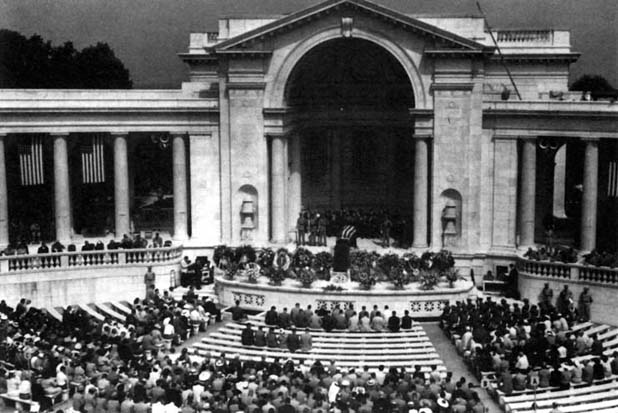
Gravesite Services – Rifle Volley
Michael Robert Patterson was born in Arlington and is the son of a former officer of the US Army. So it was no wonder that sooner or later his interests drew him to American history and especially to American military history. Many of his articles can be found on renowned portals like the New York Times, Washingtonpost or Wikipedia.
Reviewed by: Michael Howard

